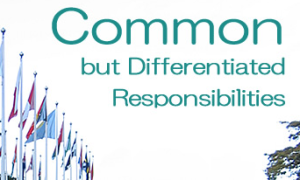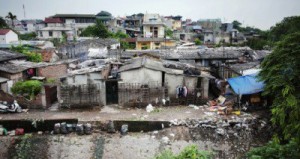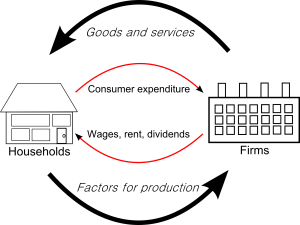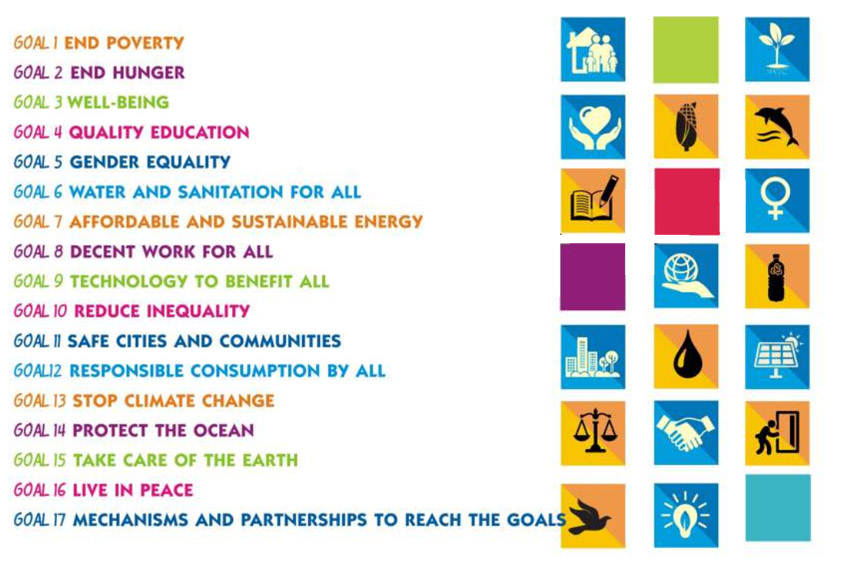The politics of the Sustainable Development Goals (SDGs)
Dario Kenner (Why Green Economy?) October 2015
The Sustainable Development Goals (SDGs) were agreed in late September 2015. This page provides links to selected reports and analysis that are useful in navigating through some of the most important debates on the SDGs.
Introduction
The mandate to develop the SDGs was one of the main outcomes of the UN Conference on Sustainable Development (Rio+20) held in Rio in June 2012. They will replace the Millennium Development Goals and are expected to last from January 2016 until 2030 [Frequently Asked Questions about the post-2015 process / Interactive list of the SDGs compared to the Millennium Development Goals]
The negotiations
The draft text including the 17 Sustainable Development Goals (with 169 targets) was officially signed off by the world’s government’s in late September 2015.
For a comprehensive summary of reaction to the UN sustainable development summit see the IRF update and coverage by Reuters.
The document that formed the basis of the negotiations was released at the start of June 2015: Zero draft of the outcome document for the UN Summit to adopt the Post-2015 Development Agenda. For reaction to the zero draft see links to comment articles. Graphic summary of the state of negotiations showing where countries agree/disagree (July 2015)
Useful links for background and news on the SDGs and the negotiation process
The politics of the SDGs
Below are selected links to reports and analysis on the central SDG debates. A variety of sources are provided on each theme to give an insight in to the different perspectives on what the SDGs should include and how they should be implemented. There are of course many more voices and opinions on each area.
————————————
 How should the universality of the SDGs be interpreted? How should the principle of common but differentiated responsibilities be implemented?
How should the universality of the SDGs be interpreted? How should the principle of common but differentiated responsibilities be implemented?
Unlike the MDGs it is proposed the SDGs are universal and therefore apply to all countries. However, there is a on-going debate as to what this means in practice. At the heart of this debate is whether the principle enshrined in the Rio declarations (1992 Earth Summit) of common but differentiated responsibilities (CBDR) is upheld in the SDG process and affects how they are financed.
- North-South debate in the UN within context of Sustainable Development Goals (Third World Network / 2014).
This summary of the SDG negotiations explains, “developing countries unanimously clarified that while the sustainable development goals are universal to all countries in terms of their nature and relevance, the degree of national responsibility in the implementation of the goals should be differentiated in accordance with the varying capacities, realities and developmental levels of countries.” For example during the negotiations India “stressed that the urgency for sustainable development requires developed countries to take the lead by shifting their societies and economies to sustainable consumption and lifestyle patterns in accordance with the CBDR principle.
- Universality, common but differentiated responsibilities and the Sustainable Development Goals (SWP working paper / April 2015).
This paper discusses whether the principle of CBDR only covers environmetal protection or is an overarching principle. It finds “there is an increasing trend by developing states to associate the Principle of CBDR with more financial support, usually referred to as ‘means of implementation’ (MoI), rather than the differentiation in implementing substantive commitments. This means that invoking the Principle is a way of requesting more resources.” Meanwhile “industrialised countries argue that the dichotomy between developed and developing countries, created by the Rio Principle of CBDR and consolidated in the UNFCCC and Kyoto Protocol Annexes, is no longer tenable to the extent that emerging economies (such as China, India, Brazil and South Africa) still fall under the category of developing countries without clear and binding responsibilities.”
- Common But Differentiated Governance: Making the SDGs Work (PublicStrategy for Sustainable Development / April 2015).
The authors argue that “applying “common but differentiated” to governance touches less upon the issue of greater historical and/or recent burden (on the environment) and related responsibility, but focuses on implementation (of whatever specific level of targets). It points directly to the countries and other levels, where the work of implementation will need to take place.”
See also:
A Universal Agenda? Echoes of Colonial Power Dominate Post 2015 negotiations (UN Women’s Major Group / August 2015)
The Sustainable Development Goal Dance: Two steps forward, one step back (Action Aid / August 2015)
————————————
 Financing for Development – Who will pay to implement the SDGs?
Financing for Development – Who will pay to implement the SDGs?
One of the most controversial issues around the SDGs is where the finance will come from to implement them. Financing needs are estimated to be around $17 trillion. Should funding come from public and/or private sources? Which countries will end up funding the SDGs? How will this affect what the SDGs prioritise and who benefits from their implementation?
The key financing for development conference was held in Ethiopia in July 2015. Reaction to the conference:
Did the UN financing for development conference deliver? (Thomson Reuters / July 2015)
Official Addis Ababa Action Agenda agreed upon at the conference.
United Nations press release: UN Secretary-General Ban Ki-moon said, “This agreement is a critical step forward in building a sustainable future for all. It provides a global framework for financing sustainable development.”
Countries agreed to: establish a Technology Facilitation Mechanism; establish a Global Infrastructure Forum; adopt a new social compact in favour of poor and vulnerable groups; consider taxing harmful substances such as tobacco; promote affordable and stable access to credit for smaller enterprises; recommitted to achieve the target of 0.7% of gross national income for official development assistance; developed countries commit to reverse the decline in aid to the poorest countries; calls for strengthening support for the work of the UN Committee of Experts on International Cooperation in Tax Matters; calls on developed countries to implement their commitment to a goal of jointly mobilizing US$100 billion per year by 2020 from a wide variety of sources to address the needs of developing countries; countries also committed to phase out inefficient fossil fuel subsidies that lead to wasteful consumption.
Critiques of the Addis Ababa Action Agenda
Key parts of civil society response to the outcome: “We, members of hundreds of civil society organizations and networks from around the world would like to express our deepest concerns and reservations” with the outcome of the Addis Ababa conference which was a lost “opportunity to tackle the structural injustices in the current global economic system and ensure that development finance is people-centred and protects the environment.” “We regret that the negotiations have diminished the FfD mandate to address international systemic issues in macroeconomic, financial, trade, tax, and monetary policies, while also failing to scale up existing resources and commit new financial ones.” The outcome document “is also deeply inadequate to support the operational Means of Implementation (MoI) for the Post-2015 Development Agenda, exposing an unbridged gap between the rhetoric of the aspirations and reality of the actions.”
International Trade Unions Confederation: UN Development Finance Conference: Lack of Ambition and Weak Commitments put Private Sector in the Driving Seat.
Oxfam International: Unresolved rigged tax rules and privatized development are the major drawbacks of the UN Financing for Development Conference.
Key background materials on the financing for development process
- Financing the sustainable development goals (Guardian podcast / June 2015)
Discussion of the politics of aid and whether the key financing for development conference to be held in Ethiopia in July 2015 will be successful.
- Report of the Intergovernmental Committee of Experts on Sustainable Development Financing (UN / 2014).
This report finds that “financing needs for sustainable development are large, but that global savings would be sufficient to meet these needs. However, current financing and investment patterns will not deliver sustainable development. While there is no one simple policy solution, a concerted effort that draws on all actors and mobilizes all resources in an integrated manner will allow to finance the investments necessary to achieve sustainable development for all.” See also: Learning from the past: Public finance and democratic control are key to achieving the SDGs (TNI / July 2015)
- Geopolitical analysis of Financing for Development (Regions Refocus 2015, Third World Network and DAWN / March 2015).
This briefing argues developed countries are strongly pushing for “domestic resource mobilization as a primary vehicle for development” i.e. each country finds it’s own money. They argue developed countries want to avoid their historical responsibility to “contribute to global development” and “also evades a discussion of the need for these states to reaffirm – and fulfill – their promises to provide aid”. Meanwhile developing countries (the G77 and China) call for financing to be provided via aid from developed countries and also to reduce illicit financial flows (via tax evasion and trade and services mispricing, and also transfer pricing).
- From Billions to Trillions: Transforming Development Finance Post-2015 Financing for Development: Multilateral Development Finance (Joint statement by World Bank Group, ADB, AsDB, EIB, IDB and the International Monetary Fund / April 2015).
This statement argues: “A paradigm shift on how development will be financed is required to unlock the resources needed to achieve the SDGs. The world needs intelligent development finance that goes well beyond filling financing gaps and that can be used strategically to unlock, leverage, and catalyze private flows and domestic resources. Official Development Assistance (ODA) will remain an important source of external public financing. ODA levels can and should rise as developed countries increase assistance levels – and all available grant funding is critical and should be used as effectively as possible. Yet ODA flows are only a small part of development flows. In the future, ODA must be targeted increasingly to crowd in other funding sources: (i) for Low-Income Countries (LICs), on the basis of poverty, vulnerability, and limited fiscal capacity; and (ii) for Middle-Income Countries (MICs), by playing an increasing role to leverage and catalyze public and private sources of financing.” See also: UN Financing for Development: the International Monetary Fund and World Bank’s role & influence (Bretton Woods Project / July 2015).
- Financing for Development Conference 2015: Views from the Global South (Manuel Montes / April 2015)
This briefing notes the financing for development conference in July 2015 in Ethiopia will take place at a time “when the global economy will still be struggling to overcome the near collapse in 2007-2008 of the international financial system” and for the countries of the global South the “reality is that they are net investors in developed countries.” The briefing concludes that what is at stake for developing countries at the July 2015 financing for development conference in Ethiopia, “is not so much how much more financing can be made available, but rather the extent to which future financing flows are fit for the purpose of achieving the agreed goals of sustainable development.”
- Will climate change render the SDGs impossible? (Helena Wright / May 2015)
This blog notes, “Climate change will add to the costs of achieving the post-2015 goals in developing countries” and that the “impacts of climate change on the SDGs raises even bigger questions. How will the finance for the post-2015 goals support or enable action on climate change? How can we ensure the goal of providing ‘energy for all’ can be done with clean energy? How will the SDGs help countries to adapt to climate change impacts?”. Full report: Impact of climate change on Least Developed Countries: are the SDGs possible? (IIED / May 2015)
————————————
 Will the SDGs successfully reduce poverty and inequality?
Will the SDGs successfully reduce poverty and inequality?
The first SDG goal is to “End poverty in all its forms everywhere”. Will the SDGs realistically deliver on this in the way they are currently designed?
-
Top incomes drive inequality – so why does the inequality target ignore them? (Alex Cobham, Lukas Schlogl and Andy Sumner / The Guardian, September 2015).
The authors observe that the: “specific goal on inequality relates to the bottom 40% of the population, requiring that their income growth is sustained at a rate higher than the national average. This measure ignores the top of the distribution – the rich – so it feels more like an assessment of the pro-poorness of growth, or how much this growth benefits the poor. By creating an inequality target that doesn’t involve the top end – the rich – the SDG target actually allows room for greater income concentration at the top.”
- Action/2015: Global campaign calling on world leaders via the SDGs and climate change negotiations to commit to: 1) An end to poverty in all its forms; 2) The meeting of fundamental rights, tackling inequality and discrimination; 3) An accelerated transition to 100% renewable energy; 4) A world where everyone can participate and hold their leaders accountable.
- It will take 100 years for the world’s poorest people to earn $1.25 a day (Jason Hickel/ The Guardian, March 2015).
Hickel argues “The sustainable development goals will aim to eradicate poverty by 2030 but our current economic model, built on GDP, could never be inclusive or sustainable” and concludes “the corporations and rich-country governments that control the SDG process are very unlikely to adopt the change needed to truly eradicate poverty, because it would threaten the interests of the global 1%.” See also: The Problem with Saving the World: The UN’s new Sustainable Development Goals aim to save the world without transforming it (Jason Hickel / Jacobin magazine, August 2015)
- Goals for the rich: Indispensable for a Universal Post-2015 Agenda (Civil Society Reflection Group on Global Development Perspectives / March 2015).
This briefing argues current SDGs targets make the “reduction of inequality dependent on steady economic growth”, “refrain from referring to the need to redistribute income and wealth” and do not “mention any relationship between the incomes of the rich (particularly the one per cent) and those of the poor.” The SDGs should recognise “the rich and powerful have special responsibilities” which require changes in the domestic policies of rich countries, “domestic policies in order to reduce negative external effects beyond a country’s borders and those that zero in on their international duties and responsibilities”. See also: Facing up to the awkward realities of the post-2015 agenda (IIED, January 2015)
- Will these Sustainable Development Goals get us into the doughnut? (Kate Raworth / August 2014).
This blog concludes the “draft SDGs contain much to celebrate, but are lop-sided in ambition, and deluded on economic growth. As they stand, they’ll get us over the social foundation, but not back under the environmental ceiling. And human wellbeing depends fundamentally on both.” See also: Sustainable Development Goals and Inclusive Development (UNU-IAS / October 2014).
————————————
 Which economic model will be the basis of the SDGs?
Which economic model will be the basis of the SDGs?
As the evidence increases that the current economic model is unsustainable there is growing pressure for new economic policies. Will the SDGs lead to a structural change in the global economy or a continuation of business as usual?
- Eradicating Poverty through an Inclusive Green Economy (United Nations Enviroment Programme / 2015).
This UNEP post-2015 briefing note argues, “ending poverty can be achieved if sustainable economic growth, social protection, and environmental health and stewardship are considered together. Giving a proper value to natural capital and ecosystem services, protecting, restoring and enhancing natural assets, ensuring equitable access to natural resources and sustainably-derived basic services, promoting green and innovative fiscal policies and investments, and tracking progress through new indicators should be part of the drive towards eradicating poverty irreversibly through smart, sustainable and inclusive growth.” See UNEP page on the post-2015 process.
- Growth within Natural Limits: The Debates, Propositions and Possibilities (Southern Voice / February 2015).
This paper notes “overall, the language in the proposed SDGs is supportive of “sustainable development” and the “targets related to the social domain have a high degree of ambition and clarity”. However, it concludes, “the SDGs are least ambitious in terms of achieving sustainability in their attempts to catalyse the transformation of the global economy. They do not clearly subscribe to the fundamentals of biophysical limits and swing between tweaking the existing system and proposing an alternative model. The goals do not address sustainable consumption and production as a cross-cutting theme, which may be the SDGs’ greatest weakness.”
- Can post-2015 sustainable development goals survive neoliberalism? (Emmanuel Kumi, Albert A. Arhin, Thomas Yeboah / 2014).
The paper argues “that the tenets of neoliberal economic agenda such as commodification, deregulation, privatisation and cuts in government expenditure may in some context undermine the attainment of sustainable development by increasing poverty and inequality. This in turn increases the exploitation of environmental resources, such as forests, as a result of poverty-induced constraints. Additionally, the regulatory capacity of environmental management provided by the state has been reduced mainly due to budgetary constraints imposed by the adoption of neoliberalism.”
- Can the Sustainable Development Goals reduce our appetite? (Lewis Akenji / 2014)
This discussion paper argues: “forty years after the first UN meeting on the environment (1972 in Stockholm), not one country can show that it has achieved absolute decoupling of economic growth from environmental stress. For a start, an acknowledgement of this failure needs to be strongly reflected in the design of the SDGs framework. Issues relating to poverty, inequity, health, excesses of wealth, aspirations, etc., are as fundamental to patterns of consumption and production as technology is to production processes. Beyond just technical tweaks and hopes for absolute decoupling, getting to SCP through the SDGs framework would require nothing short of a critical review of the culture of consumerism”.


Leave a Reply